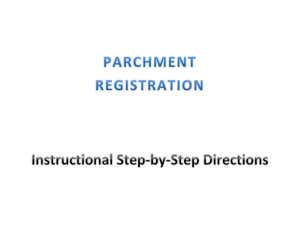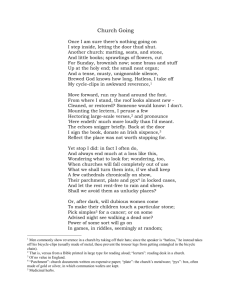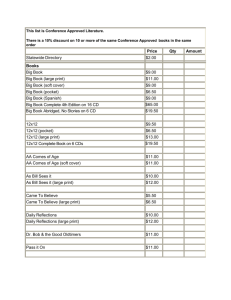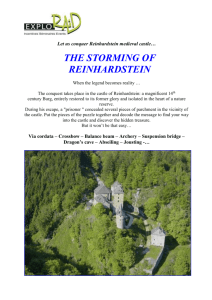e-PS, 2009, , 138-144 ISSN: 1581-9280 web edition ISSN: 1854-3928 print edition
advertisement
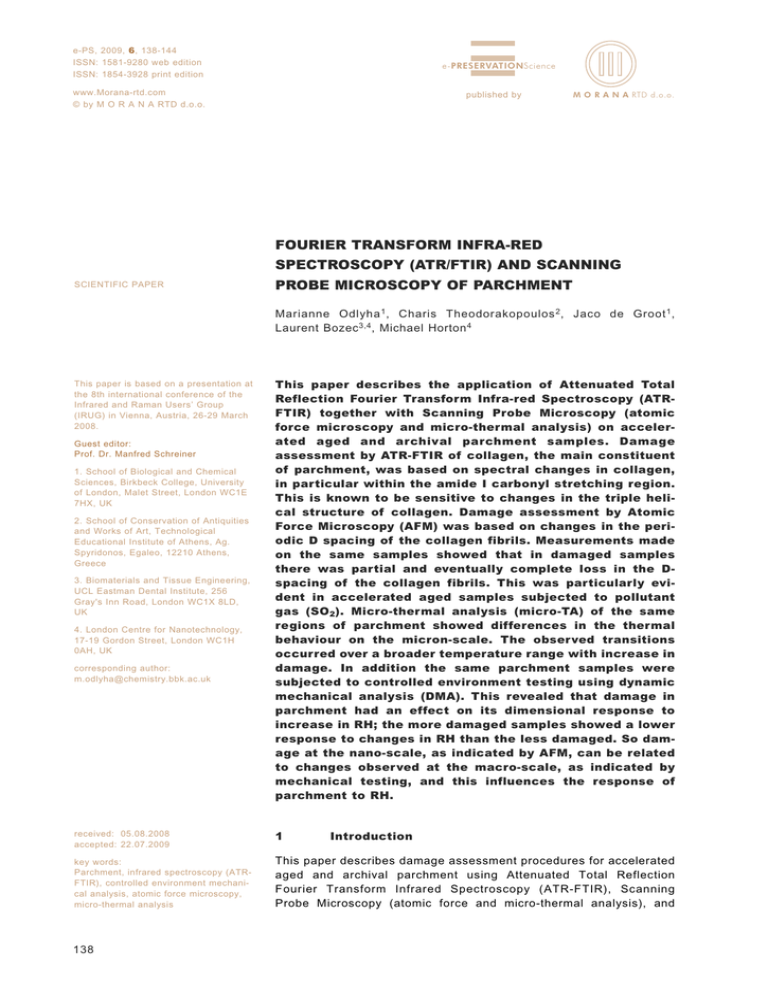
e-PS, 2009, 6, 138-144 ISSN: 1581-9280 web edition ISSN: 1854-3928 print edition e-PRESERVATIONScience www.Morana-rtd.com © by M O R A N A RTD d.o.o. published by M O R A N A RTD d.o.o. FOURIER TRANSFORM INFRA-RED SPECTROSCOPY (ATR/FTIR) AND SCANNING SCIENTIFIC PAPER PROBE MICROSCOPY OF PARCHMENT Marianne Odlyha 1 , Charis Theodorakopoulos 2 , Jaco de Groot 1 , Laurent Bozec 3,4 , Michael Horton 4 This paper is based on a presentation at the 8th international conference of the Infrared and Raman Users’ Group (IRUG) in Vienna, Austria, 26-29 March 2008. Guest editor: Prof. Dr. Manfred Schreiner 1. School of Biological and Chemical Sciences, Birkbeck College, University of London, Malet Street, London WC1E 7HX, UK 2. School of Conservation of Antiquities and Works of Art, Technological Educational Institute of Athens, Ag. Spyridonos, Egaleo, 12210 Athens, Greece 3. Biomaterials and Tissue Engineering, UCL Eastman Dental Institute, 256 Gray's Inn Road, London WC1X 8LD, UK 4. London Centre for Nanotechnology, 17-19 Gordon Street, London WC1H 0AH, UK corresponding author: m.odlyha@chemistry.bbk.ac.uk This paper describes the application of Attenuated Total Reflection Fourier Transform Infra-red Spectroscopy (ATRFTIR) together with Scanning Probe Microscopy (atomic force microscopy and micro-thermal analysis) on accelerated aged and archival parchment samples. Damage assessment by ATR-FTIR of collagen, the main constituent of parchment, was based on spectral changes in collagen, in particular within the amide I carbonyl stretching region. This is known to be sensitive to changes in the triple helical structure of collagen. Damage assessment by Atomic Force Microscopy (AFM) was based on changes in the periodic D spacing of the collagen fibrils. Measurements made on the same samples showed that in damaged samples there was partial and eventually complete loss in the Dspacing of the collagen fibrils. This was particularly evident in accelerated aged samples subjected to pollutant gas (SO 2). Micro-thermal analysis (micro-TA) of the same regions of parchment showed differences in the thermal behaviour on the micron-scale. The observed transitions occurred over a broader temperature range with increase in damage. In addition the same parchment samples were subjected to controlled environment testing using dynamic mechanical analysis (DMA). This revealed that damage in parchment had an effect on its dimensional response to increase in RH; the more damaged samples showed a lower response to changes in RH than the less damaged. So damage at the nano-scale, as indicated by AFM, can be related to changes observed at the macro-scale, as indicated by mechanical testing, and this influences the response of parchment to RH. received: 05.08.2008 accepted: 22.07.2009 1 key words: Parchment, infrared spectroscopy (ATRFTIR), controlled environment mechanical analysis, atomic force microscopy, micro-thermal analysis This paper describes damage assessment procedures for accelerated aged and archival parchment using Attenuated Total Reflection Fourier Transform Infrared Spectroscopy (ATR-FTIR), Scanning Probe Microscopy (atomic force and micro-thermal analysis), and 138 Introduction © by M O R A N A RTD d.o.o. controlled environment Mechanical Analysis (DMA). It is part of the work that was performed within the framework of the IDAP project “Improved Damage Assessment of Parchment” where over 100 accelerated aged and archival samples were studied. 1,2 The rationale for using a range of analytical techniques in the IDAP project was based on the fact that collagen has a hierarchical structure and the objective was to determine whether damage could be observed at different structural levels. Previous studies using FTIR on historical collagen containing material, the Dead Sea scrolls, measured differences in intensities and positions of amide I and amide II absorbances and this was taken as an indication of the extent of collagen degradation. 3 In the IDAP project and the data reported in this paper the approach used for archival parchment has been to focus on the amide I region of the spectra. The rationale for this was to avoid the problems of influences from inorganic additives. The amide I region can be resolved into non-equivalent amide carbonyls present in the triple helix of collagen; one within the triple helix and capable of intramolecular hydrogen bonding at 1660 cm -1 and the other at 1630 cm -1 directed outwards in the triple helix and capable of intermolecular hydrogen bonds with water molecules. 3 Significant changes in the peak height ratio of 1660/1630 cm -1 have been associated with severe degeneration of the collagen triple helical structure. 4 With regard to the mechanical properties of parchment previous studies in the project Microanalysis of Parchment (MAP) focused on immersion of parchment in water and the measurement of creep as temperature increased to shrinkage temperature values. 5 In the IDAP project and the data presented in this paper the dimensional behaviour of parchment under an increasing and controlled RH is reported. 1 The application of micro-thermal analysis to parchment follows on from some preliminary work in the MAP project using micro-thermal analysis. 6 MicroTA showed differences in thermal behaviour in parchment on the micron-scale in terms of the number and the temperature range of the observed transitions. Atomic force microscopy (AFM) was used for the first time in the IDAP project to study collagen fibril structure in parchment and to assess damage. 1,7 In other areas of research it has been extensively used to study collagen from different tissues of the mammalian body such as rat tail collagen and bone. 8 One of the main outcomes from the AFM studies on parchment in the IDAP project is the observation that variations in the extent of the banded fibril structure was an indicator of damage. 1,7 Furthermore the absence of this structure could be linked with gelatinization, as indicated by shrinkage temperature measurements, 2 and the lack of dimensional response in parchment to changes in relative humidity. 1 In this paper the effect of thermal denaturation and ageing using SO 2 gas will be discussed in terms of the changes observed in the ATR/FTIR spectra, the presence or absence of banded fibril structure and the dimensional response in parchment. Examples will then be given of damage assessment on archival samples, including a 13 th century manuscript. 2 Materials and Methods 2.1 Samples Samples in the IDAP project included unaged reference samples (Z. H. De Groot, The Netherlands), and those that had undergone accelerated ageing with dry and humid heat, light, inorganic pollutants (SO 2 , NO 2 ) under controlled conditions. 1 Historical samples from the following archives: Archivio di Stato, Florence, National Archives, Scotland, the Royal Library and School of Conservation, Copenhagen, and the Municipal Archive, Segovia, Spain, were also studied. Samples were provided by conservators who had previously performed visual assessment of damage which included ranking according to the following properties: colour, stiffness, hairholes for identifying animal type, degree of transparency, indication of extent of calcite deposits, evidence of microbial damage. 2 Measurements were also made of shrinkage temperature ( Ts) of the fibres. 2 In this paper a selection of samples is discussed. For the accelerated aged samples these include samples which were thermally aged by controlled heating to 220 ºC and samples aged using SO 2 gas. The climate chamber in the Centre de Récherches sur la Conservation des Documents Graphiques (Paris) was used for the ageing tests and samples were exposed to SO 2 gas (50 ppm) at 50% RH and 25 ºC for periods of 2, 4, 8 and 16 weeks. 2 2.2 Fourier Transform Infra-red Analysis (ATR-FTIR) ATR-FTIR spectra were recorded using a PE 2000 FTIR spectrometer with a TGS detector and a “SensIR Technologies” Durascope placed in the sample compartment. This was fitted with a ZnSe internal reflectance element (IRE) held at 45º to the incident beam. Using these conditions the depth of penetration into the sample at 1050 cm -1 is about 2 μm. 9 Spectra were recorded with the FTIR and AFM of parchment , e-PS, 2009, 6, 138-144 139 www.e-PRESERVATIONScience.org grain side of the parchment in contact with the IRE in the range 4000 to 800 cm -1 at a resolution of 4 cm -1 . The data were processed using GRAMS32 AI software by Galactic ® . All spectra resulted from the co-addition of 16 scans. Reproducibility was ensured by keeping constant the force between the samples and the ZnSe crystal, using the graded scale of the Durascope. 2.3 Controlled Environment Mechanical Analysis (DMA) Prior to mechanical testing, samples were predried for 24hrs in a desiccator. They were then mounted in the tensile clamp of the Dynamic Mechanical Analyser (DMA TRITEC2000B). For thermal ageing samples were heated at 3 ºC/min to 220 ºC. 3 Results and Discussion 3.1 Accelerated Aged Samples 3.1.1 Thermal Denaturation Figure 1 shows the ATR-FTIR spectra of (1) unaged parchment and (2) the same sample after heating to 220 ºC. Heating to this temperature is known to cause thermal denaturation in collagen in a dehydrated state. 10 In ATR-FTIR there was a pronounced shift of the amide II band of the order of 10 wavenumbers (1540 to 1530 cm -1 ) and which coincided with the value observed for amide II in gelatin. The shift in amide II as an indication of denaturation was previously reported in the study on the Dead Sea scrolls. 3 In Figure 1 in addition to the amide II shift there is also a change in intensity of the 1660 and 1690 cm -1 sub-bands within amide I. Alterations in these sub bands have been For testing dimensional response the Triton RH controller unit was used together with the DMA and the starting conditions were set to 20% RH and 25 ºC. Once the sample had stabilised under these conditions then the RH was increased at 1%/min until 80% RH and it was left at 80% RH for 30 min. Sample dimensions were typically 5(l) x 4.50(w) x 0.2 (t) mm. 2.4 Atomic Force Microscopy (AFM) AFM was performed using a Dimension 3100Nanoscope IV AFM (Veeco, Santa Barbara, USA) and a Nanowizard AFM (JPK, Berlin,Germany). Both were operated in contact mode using DNPS cantilever (Veeco). 2.5 Micro-Thermal Analysis (micro-TA) Localised thermomechanical measurements were performed with an Explorer AFM (Veeco, Santa Barbara, USA) that was modified with a micro-TA unit (TA Instruments, USA). A commercially available Wollaston wire probe (Veeco) was calibrated using the melting temperature of polymeric materials. Localised thermal analysis measurements were performed from 20 to 550 ºC at 20 ºC/s. Measurements were made at several locations with a distance of 0.2 mm between them. Observed transitions were characterised by measuring the deflection of the probe as the probe temperature was ramped up to the melting/degradation point of the sample. In addition the first derivative of the thermal power dissipation signal (heat absorbed by the sample) was calculated. 7 140 Figure 1: ATR/FTIR spectra (1800-1400 cm-1) of unaged parchment (dashed line) and thermally denatured parchment (full). Peaks correspond to amide I-II. Figure 2: AFM images of unaged parchment (A) and thermally denatured parchment (B, C). Blue line (C&D) shows measurement of the banding periodicity of the sample 45±10 nm. 6 FTIR and AFM of parchment , e-PS, 2009, 6, 138-144 © by M O R A N A RTD d.o.o. related to cross-linking of collagen in bone during denaturation. 11 AFM images of the thermally denatured sample showed that the banded fibril structure which occurs in the unaged sample [Figure 2(A)] could not be observed and the surface had a “glass-like” appearance [Figure 2(B)]. However, in one location an intact banded fibril structure was observed with a banding periodicity of 45±10 nm [Figure 2(C) and 2(D)]. This differed from the same unaged sample, prior to thermal denaturation, which had a banding periodicity of 64±3 nm [Figure 2(A)]. 7 3.1.2 Effect of SO2 Ageing Figure 3 shows the ATR-FTIR spectra of SO 2 aged samples (4-16 weeks, 50 ppm at 50% RH and 25 ºC) normalized on the amide I peak. In this case the shift in amide II was not as significant as the noticeable decrease in the amide II peak and evolution of a band at about 1335 cm -1 which occurs after the first 4 weeks of exposure. This band can be assigned to the asymmetric stretching of sulfone in a C-SO 2 -C conformation in methionine sulfone (MetSO 2 ) which provided a marker of collagen oxidation. 12 The same SO 2 exposed samples were analysed by mass spectrometric techniques which confirmed that oxidative damage had occurred. 13 Mechanical analysis of the samples exposed for 4 weeks to SO 2 showed a decrease in displacement (%) with linearly increasing RH, relative to the control sample (Figure 4). This occurred also in the case of the thermally aged sample where the effect was even more severe and there was almost no response with increasing RH. 1 the collagen fibrils. In the 16 weeks exposed sample there is complete loss of structure and formation of a glass-like surface, also observed by scanning electron microscopy. 14 Figure 6 shows the first derivative of the thermal power dissipation curves as calculated from the micro-TA data. Data for the light aged sample (16 h of light at 170±1 klux) are also shown for comparison. The onset temperature for the latter is similar to the control but the transition occurs over a broader temperature range. Measurement of the peak area in the temperature range 300-400 ºC showed a reduction of about 30% and a decrease in shrinkage temperature of 12 ºC compared to that of the unaged sample. 7 Samples exposed 16 weeks to SO 2 showed more change. Figure 6 depicts that the onset temperature was lower showing a reduced thermal stability compared to that of the control, and measurement of the peak area in the temperature range Figure 4: Controlled environment mechanical analysis (%D vs. time (min)/RH (%) of control (top) and sample exposed to 4 weeks SO2 (lower curve). Figure 5 shows the AFM images of samples exposed to increasing doses of SO 2 . The images clearly show the progressive loss of D-banding in Figure 3: ATR/FTIR spectra (1800-1100 cm-1) of unaged parchment (black) and then exposed to SO2 for 4, 8 and 16 weeks (red, green and dark blue), respectively. Figure 5: Unaged parchment (A), 2 weeks (B), 4weeks (C), and 16 weeks (D) exposed to SO2 FTIR and AFM of parchment , e-PS, 2009, 6, 138-144 141 www.e-PRESERVATIONScience.org and/or lipid content as determined by other techniques. 15 Figure 6: Micro-TA: First derivative of power curves for unaged parchment SC70:2 (black), light aged CR05 (16 h, 170±1 klux) (blue), and CR33 exposed 16 weeks to SO2 (50 ppm 50% RH and 25 oC) (red). 300-400 ºC showed a reduction of almost 40% and a decrease in shrinkage temperature of 16 ºC compared to that of the unaged sample. 7 3.2 Archival Samples ATR/FTIR spectra of archival samples showed differences between flesh and grain sides. The flesh side usually exhibited a dominant band for carbonate (1450-1400 cm -1 ), which had a strong effect on the adjacent amide bands, in particular the amide II band (1580-1485 cm -1 ) (Figure 8). For this reason the spectra from the grain side were used for damage assessment. For the historical samples values for the ratio of absorbances at 1660 and 1630 cm -1 were calculated. This provided sufficient variation so that ranking of damage could be made. Table 1 shows the ranking of damage for the historical samples according to 4 categories and this was based on percentage deviation from the reference sample. The samples are fully described elsewhere, 1,2 as is the comparison of damage ranking as measured by other techniques. Generally it was observed that the more damaged samples were frequently those with higher mineral Damage categories 1: 2: 3: 4: Change of School of Conservation, 1660:1630 Copenhagen SC59:2, SC69:2, Not damaged 0 - 5% SC70:2, SC76:1 SC17:1, SC31:1, SC32, SC58:2, SC59:1, Slightly 5 - 12% SC70:1, SC76:1,SC77, Damaged SC16, SC35, SC58:1, SC38:2 SC56:1, SC24, SC18, Considerably 12 - 20% SC38:1, SC72:1 &2, Damaged SC75:1, SC73:2 Very >20% SC17:2, ,SC75:2 Damaged In this paper two of the samples shown in Table 1 will be discussed: SC72 and SC175. SC72 is a book binding (calf, 18 th century). Damage assessment by FTIR was performed on samples which were distributed by the School of Conservation in Copenhagen and which were taken from two locations (SC72:1) and (SC72:2). Visual assessment was made on the larger piece and the whole piece was ranked as slightly damaged. Shrinkage temperature measurements from the two locations were 48 °C and 41.6 °C for SC72:1 and SC72:2 respectively. From the ATR/FTIR spectra, assessment of damage was estimated in category 3 (considerably damaged) as was the ranking from the response to dimensional change with RH. 1 The other sample, SC175, was from a book binding from the Archivio di Stato, Florence. The ATR/FTIR spectra for samples SC175:1 and SC175:2 (Figure 8) differ significantly. SC175:1 shows a change in amide 1 with evolution of structure on the high wavenumber side together with additional peaks in the regions 1740 cm -1 (marked d) and 1795 cm -1 (marked e) which indicate the presence of lipids and carbonates, respectively. Damage assessment by ATR/FTIR indicates that the amide1 in SC175:2 has a higher 1660/1630 ratio than SC175:1 and is therefore more damaged. This corresponds with the higher values obtained for shrinkage temperature for SC175:1 ( T s = 36.6 ºC) and for SC175:2 ( T s = 35.9 ºC). 2 It also corresponds with evaluation by AFM in terms of disturbance to the periodicity of banding of collagen and with micro-thermal analysis where the measured peak area for thermal power dissipation was reduced by over 60% in sample SC175:2. 7 The oldest sample that was studied came from the Municipal Archive, Segovia, Spain. This is a 13 th century manuscript. ATR/FTIR evaluation placed this in category 2 (slightly damaged). Visual assessment of the area investigated and shrinkage temperature measurement (55.9 ºC) concurred with this low level National Archives, Archivio di Stato, of damage. It was also Scotland Florence supported by AFM where SC115, SC117, C123 SC163, SC165:2 distinct collagen banding was observed 16 and by SC164, SC165:1 SC166, micro-thermal analysis SC116, SC118, SC119 SC168, SC173:2, data (Figure 9). The latter SC175:1 shows that the measured peak area is similar to SC114, S124, SC125 N/A that of the control and differs significantly from the SC169, SC172, SC122, SC120 SC173:1, SC175:2 thermally aged sample. 7 Table 1: Damage classification of historical parchments according to ATR-FTIR. 1 142 FTIR and AFM of parchment , e-PS, 2009, 6, 138-144 © by M O R A N A RTD d.o.o. 4 Figure 7: ATR/FTIR spectra of sample SC72:1 (18th cent, calf) flesh and grain sides. Figure 8: ATR/FTIR spectra at two locations of the same sample: SC175:1 (dash) and SC175:2 (full). ATR/FTIR provides a useful non-destructive rapid screening test for parchment. 1,17 In the case of historical parchment the presence of calcium carbonate and other inorganic fillers can be readily identified. Ranking of damage in terms of the 1660:1630 cm -1 ratio has been shown to be possible for historical samples, though it is useful to have the mechanical testing and scanning probe techniques to complement the evaluation. For the historical samples discussed above damage was evaluated in terms of ATR/FTIR, mechanical testing and scanning probe microscopy. For the accelerated aged samples, SO 2 ageing and thermal ageing the ratio 1660:1630 cm -1 was not found to be as useful as for the historical samples. In the thermally aged samples the change in ATR/FTIR was the shift in the amide II peak with changes in the region 1690 and 1660 cm -1 . The change in micro-TA for these samples showed a shift of the observed peak to higher temperature and it remained over a narrow temperature range (Figure 9). This differed from the micro-TA curves observed for the SO 2 aged samples where the peaks occurred over a broader temperature range. This may be due to differences in mechanisms of degradation of collagen. In the case of thermal denaturation the change could be due to shrinkage as shown by the changes in the AFM images and cross-linking which is supported by the changes at 1690 and 1660 cm -1 in ATR/FTIR. 10 In the case of SO 2 ageing, oxidative damage occurs and this is confirmed by mass spectrometry. 13 The database that has been obtained in IDAP (http://www.idap-parchment.dk) makes it possible to evaluate the approach using ATR-FTIR. The use of mechanical analysis and measurement of the response to RH can contribute to improved conservation treatment of parchment and to improved display and storage of parchment. The further aim in the application of scanning probe techniques is to achieve non-invasive non-destructive damage assessment which would be a requirement for rare historical documents. Currently work is in progress with samples in the context of the Piedmont region research project “Old Parchment, Evaluation, Restoration and Analysis”. 5 Figure 9: Micro-TA: First derivative of power curve for control (black), 13th cent sample (blue) and thermally denatured sample (red). 7 Conclusions References 1. M. Odlyha, C.Theodorakopoulos, J. de Groot, L. Bozec, M. Horton, Thermoanalytical (macro to nanoscale) techniques and non-invasive spectroscopic analysis for damage assessment of parchment, in: Improved Damage Assessment of Parchment, IDAP EC Research report No. 18, (ISBN 978-92-70-05378-8), 73-85. 2. R. Larsen (Ed.), Improved Damage Assessment of Parchment, IDAP EC Research report No. 18, (ISBN 978-92-70-05378-8). FTIR and AFM of parchment , e-PS, 2009, 6, 138-144 143 www.e-PRESERVATIONScience.org 3. M. Derrick, Evaluation of the State of Degradation of Dead Sea Scroll Samples using FT-IR Spectroscopy, The American Institute for Conservation, 1991, http://aic.stanford.edu/sg/bpg/annual/v10/bp10-06.html (accessed 03/08/2009). 4. N. R. Vyavahare, D. Hirsch, E. Lerner, J. Z. Baskin, R. Zand, F. J. Schoen, R. J. Levy, Prevention of calcification of glutaraldehydecrosslinked porcine aortic cusps by ethanol preincubation: Mechanistic studies of protein structure and water-biomaterial relationships, J. Biomed. Mater. Res., 1998, 40, 577-585. 5. M. Odlyha, N. S. Cohen, G. M. Foster, R. Campana, Characterization of historic and unaged parchments using thermomechanical and thermogravimetric techniques, in: Microanalysis of Parchment (MAP), R. Larsen (Ed.), Archetype Publications, London, 2002, 73-89. 6. M. Odlyha, N. S. Cohen, G. M. Foster, A Aliev, E. Verdonck, D. Grandy, Dynamic mechanical analysis (DMA), 13C solid state NMR and micro-thermo-mechanical studies of historical parchments , J. Therm. Anal. Calorim., 2003, 71, 939-950. 7. J de Groot, Damage assessment of collagen in historical parchment with microscopy techniques, PhD thesis, Birkbeck College, University of London, 2007. 8. L. Bozec, G. van der Heijden, M. A. Horton, Collagen fibrils:nanoscale ropes, Biophysics J., 2007, 92, 70-75. 9. A. L. Woodhead, F. J. Harrigan, J. S. Church, Assessment of chlorination of wool by infrared spectroscopy. Part 1: The classical approach, Int. J. Vibr. Spectr., 1, ed. 3, http://www.ijvs.com/volume1/edition3/section2.html (accessed 18/03/2008). 10. M. Fois, A. Lamure, M. J. Fauran, C. Lacabanne, TSC (Thermally Stimulated Current) study of the dielectric relaxations of human-bone collagen, J. Polym. Sci. B - Polymer, 2000, 38, 987992. 11. E. P. Paschalis, K. Verdelis, S. B. Doty, A. L. Boskey, R. Mendelsohn, M. Yamauchi, Spectroscopic characterization of collagen cross-links in bone, J. Bone Min. Res., 2001, 16, 1821-1826. 12. W. Vogt, Oxidation of methionyl residues in proteins: tools, targets and reversal, Free Rad. Biol. Med., 1995, 18, 93-105. 13. F. Juchauld, H. Jerosch, K. Dif, R. Ceccarelli, S.Thao, Effects of two pollutants (SO2 and NO2) on parchment by analysis at the molecular level using mass spectrometry and other techniques , in: Improved Damage Assessment of Parchment, IDAP EC Research report No. 18, (ISBN 978-92-70-05378-8), 59-68. 14. A. Mašiæ, Applicazione di techniche innovative nello studio dei processi di degrado dei manufatti di interesse artistico-culturale , PhD Thesis, University of Turin, 2005. 15. C. Ghioni, J. C. Hiller, C. Kennedy, A. E. Aliev, M. Odlyha, M. Boulton, T. J. Wess, Evidence of a distinct lipid fraction in historical parchments: a potential role in degradation, J. Lip. Res., 2005, 46, 2726-2734. 16. L. Bozec, private communication (2007). 17. G. Della Gatta ,E. Badea, A. Mašiæ, R. Ceccarelli, Structural and thermal stability of collagen within parchment: a mesoscopic and molecular approach, in: Improved Damage Assessment of Parchment, IDAP EC Research report No. 18, (ISBN 978-92-7005378-8), 89-97. 144 FTIR and AFM of parchment , e-PS, 2009, 6, 138-144
